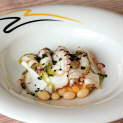In a restricted area the extreme western Ligurian, near the French border, a small number of winemakers continues with self-sacrifice the ancient culture of this great grape. Most of the grapes pressed to give rise to a ruby red wine color, timbre bright, fragrant pink and purple, dry flavor and pleasant characteristic, to be consumed young while also improving in the first three years.
VINE ROSSESE
Historical references: 
Historical sources attest that the name “Rossese” has been applied to other red grapes and white, grown in the eastern and the western Liguria; between them deserves a special mention a Rossese white of province of La Spezia, particularly valuable and sought after.
With regard to Rossese Dolceacqua, some news about his presence is found in the early 1800s when, during a visit to Napoleon at the castle of the Doria Dolceacqua, was just offered the wine, the occasion highly appreciated by distinguished guest.
Dissemination and importance:
Rossese, along with Ormeasco, can be considered the most typical wine of the Province of Imperia; its cultivation is deeply rooted in life, gastronomy and culture of countries Intemeli.
The grape is grown in the area between the French border and the eastern end of the Municipalities of Seborga and Perinaldo, includes 11 municipalities that extend into most of the valley designed by torrents Nervia and Verbone. The crop, once extended throughout the territory mentioned, today is limited to the vineyards on the slopes of these two valleys; in this restricted area you can also find some sites, called “cru”, which is particularly famous and renowned among players and industry experts.
Cultivation notes:
The Rossese of Dolceacqua is distinguished for its growing range of very small, which corresponds precisely to the area “Intemelio”; due to its high adaptability to calcareous soils and stony, from where it says it is derived the name (or rocky rocense = Rossese); technique for the cultivation to little tree, by pruning very short. Rossese’s facilities must be made on the ridges or the average hill, following a tradition now become even legally for producing DOC.
Densities are very variable in relation to the conformation of the land, and can range from 7,000 to 10,000 plants per hectare.
Rossese of Dolceacqua is generally ready for harvest between late September and early October.
Vinification:
The grape of Rossese is traditionally transformed according to the wine in “red”, or by milling of all or some of the solid parts of the bunch.
The old method involved the prolonged fermentation of must together with the skins and stems;
Recently it was claimed, albeit with difficulty and only
in some companies, an intermediate method with which the fermentation takes place in the presence of the alone skins and for a limited period.
Vinification “old” still survives in small businesses and family productions.
Enhancement of quality:
Rossese is protected at Community level by the Denomination of Origin “or Dolceacqua Rossese of Dolceacqua”, this recognition has long been, was an essential step in the maturation of professional winemakers.
The public register of the DOC now covers almost all the manufacturers. Rossese is a single-grape wine, made according to tradition on their own grapes homonym.
The specification of DOC have taken this practice, stating that the minimum quantity of grapes Rossese must be at least 95%, the remaining 5% is expected the addition of Dolcetto grapes Ormeasco. There is the name of “Rossese Dolceacqua superior”, which is reserved to wine of alcoholic least 13 ° and aged for at least a year.
Most of the vineyards of Rossese are conducted according to the AE program of the EC and the Liguria Region; there are some companies that have also taken the organic production method.
Organoleptic characteristics:
Ruby red more or less intense, with violet reflections and garnet with aging; intense vinous aroma and delicate, distinctive, dry taste, fresh, aromatic and hot, soft and velvety, with bitter vein.



